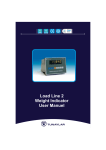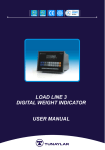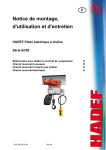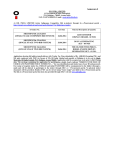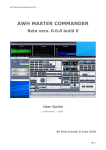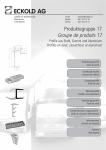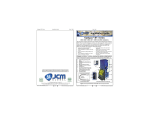Download User Guide - Main Roads Western Australia
Transcript
SRTCalculator User Guide MAIN ROADS WESTERN AUSTRALIA SRT Calculator User Guide TERNZ Ltd PO Box 11029, Ellerslie Auckland 1542, New Zealand Phone +64 9.579 2328 Table of Contents Table of Contents ........................................................................................................................... i Background ................................................................................................................................. 2 Performance Measures and Standards ........................................................................................ 3 Static Roll Threshold (SRT) ........................................................................................................ 6 Using the SRT Calculator ........................................................................................................... 9 Examples ....................................................................................................................................19 SRT Calculator User Guide Background Why prescriptive dimensions and mass regulations are not always enough. Heavy vehicle size and weight regulations exist to try to achieve a number of objectives including: • Ensuring a fit between the vehicle and the infrastructure it will operate on • Protecting the infrastructure from excessive wear or damage • Ensuring the vehicle is safe. The traditional approach to regulating size and weight has been through prescriptive requirements. These have the advantage that they are relatively easy to understand and thus to comply with. Equally, enforcement is straightforward as only simple apparatus such as a tape measure and weigh scales are needed to check compliance. For some aspects of the objectives, there is a clear direct link between a prescriptive requirement and the desired outcome. For example, the maximum height limit of 4.3m means that road controlling authorities can design overhead structures on roads with a clearance of 4.3m plus some tolerance value and be confident that all legal vehicles will fit underneath it. However, for other aspects of the objectives the link between the prescriptive requirements and the desired outcome is less clear cut. For example, the various vehicle length restrictions on the units making up a combination vehicle influence the off-tracking and hence the lane width requirement on curves and corners, but it is not a simple matter to convert from one to the other. One of the major safety issues for heavy vehicles is stability and in particular how easy it is to control the vehicle and to avoid rollover. Although prescriptive dimensions and mass requirements can be used to promote improved stability, there are many factors other than size and weight that influence stability. It is not practical to use prescriptive size and weight limits to ensure stability. For example, the steady speed rollover stability of a vehicle depends on the centre of gravity height, the track width and the compliance in the tyres, suspensions and other parts of the vehicle structure. If the size and weight limits were set so that all vehicles (including those with very compliant suspensions) would always have adequate rollover stability, this would unnecessarily reduce the load carrying capacity of the better vehicles and significantly degrade the efficiency of the road transport system. The solution, therefore, is to have some measure or measures which quantify the vehicle’s stability and impose a requirement that vehicles meet some minimum standard for these measures. This is the basis of the performance-based standards approach. 2 SRT Calculator User Guide Performance Measures and Standards What are performance measures and why are they useful. A performance measure is a defined quantity that is measured during some standard prescribed manoeuvre or test condition. Generally the manoeuvre or test condition reflects some typical in-service operating situation. A performance standard is a performance measure together with some level or levels of what constitutes acceptable performance. Although the use of performance measures and standards for controlling heavy vehicle stability is a relatively recent development with most of the measures being developed since the 1980s, the use of performance standards for some aspects of vehicle regulation is well established. For example, Table 1 in ADR 35 on commercial vehicle brake systems specifies test speeds and deceleration levels that must be achieved for various braking tests. Similarly there are regulatory requirements for turning circle based on performance. Compared to prescriptive requirements, performance standards are generally more complex to check both for initial compliance and for enforcement. However, the link between the performance measure and the in-service vehicle requirements is much more direct than is the usually the case with prescriptive requirements. For example, although the prescriptive length restrictions on vehicles do try to ensure that the vehicles have adequate manoeuvrability, satisfactory performance is not guaranteed. However, the turning circle regulation that requires a vehicle to be able to complete a 360º turn within a 25m diameter wall-to-wall circle much more directly ensures a level of capability. In the area of rollover stability there are two key performance measures that have been developed. These are Static Roll Threshold (SRT) and Dynamic Load Transfer Ratio (DLTR)1. SRT reflects the stability of the vehicle during steady speed cornering and is the lateral acceleration required to cause all the wheels on one side of the vehicle to lift off the ground. At this point the vehicle is on the verge of rollover. DLTR reflects the stability of the vehicle during an evasive manoeuvre. To determine this measure the vehicle is required to execute a specified lane change manoeuvre at highway speed and the load transfer from one side of the vehicle to the other as a proportion of the total load is determined. The maximum value of this ratio is the DLTR. The value of DLTR is always between 0 and 1 where 0 is no load transfer and 1 is complete load transfer onto one side of the vehicle i.e. rollover. There are some variations in the specification of the lane change manoeuvre that is used to assess DLTR and the value of DLTR is quite sensitive to which manoeuvre is used and to how closely the path is followed. These two measures between them reflect the most common situations where rollovers crashes occur. It should be noted that they are not independent. When a vehicle executes a lane change manoeuvre, there is a whipping effect so that the rear unit of the combination experiences more lateral acceleration that the front unit. How close the rear unit gets to rollover is related to its SRT. Thus the DLTR is related to both the magnitude of the whipping effect and the SRT. A study undertaken in New Zealand in 19992 showed a clear relationship between rollover crash risk and stability as characterised by the performance measures. Figure 1 shows the relationship between rollover 1 Some variations on these names have been used by other authors. Common alternatives are Static Roll Stability (SRS) and Load Transfer Ratio (LTR). There are also some variations in the definitions of the measures. 2 Mueller, T.H., de Pont, J.J. and Baas, P.H. Heavy Vehicle Stability versus Crash Rates. TERNZ Research Report prepared for LTSA, July 1999 available on-line at http://www.ltsa.govt.nz/publications/docs/Stability.pdf 3 SRT Calculator User Guide crash risk and stability performance as characterised by SRT. It can be seen that the poorest performing vehicles (those with an SRT < 0.3g) have four times the average rollover crash rate. Fifteen percent (15 %) of heavy combination vehicles in New Zealand did not meet the 0.35g SRT target. These vehicles represented 40% of the single vehicle loss-of control and rollover crashes. Clearly improving the performance of the poorest performing vehicles in the fleet should generate a substantial reduction in rollover crashes. 0.8 < <= 0.85 0.75 < <= 0.8 0.7 < <= 0.75 0.65 < <= 0.7 0.6 < <= 0.65 0.55 < <= 0.6 0.5 < <= 0.55 0.45 < <= 0.5 0.4 < <= 0.45 0.35 < <= 0.4 0.3 < <= 0.35 4.5 4 3.5 3 2.5 2 1.5 1 0.5 0 <= 0.3 Relative Crash Rate Fleet Rollover Rate Static Roll Threshold (g) Figure 1. Relationship between rollover crash risk and SRT. A similar relationship exists between DLTR and crash rate although in this case a higher DLTR reflects an increase in crash risk. This is not unexpected because of the inter-relationship between SRT and DLTR. SRT and DLTR can be determined by instrumenting vehicles and taking measurements during a physical test. However, this is relatively expensive (especially for DLTR where the instrumentation requirements are extensive) and thus is impractical for general application to all vehicles in the fleet. An alternative approach, which has been used in Australia for Performance Based Standards (PBS) assessments, is to use computer simulation modelling to evaluate the performance measures. Computer simulation is generally requires a substantial amount of component data which may be difficult to obtain. It also requires an analyst with a degree of expertise and experience to ensure accurate results. Although generally cheaper than physical testing, computer simulation is still too expensive to be a requirement for all vehicles. However, a good estimate of SRT can be obtained with the SRT calculator. The input quantities that are required are easily obtained. For vehicle parameters that are more difficult to obtain default generic values can be used. These are generally at the poorer end of the performance spectrum (in terms of the resulting SRT) and thus will result in a conservative estimate of SRT. For the most significant of these parameters the user has the option of obtaining more accurate data and hence improving the accuracy of the SRT estimate. The ease of use, relatively simple data requirements and good accuracy mean that the SRT calculator is a practical option for use in requiring most vehicles to meet an SRT performance standard. No equivalent calculator has been developed for DLTR. Because of the complexities of DLTR it is possible that such a calculator will never be developed. As outlined above DLTR is related to SRT and thus 4 SRT Calculator User Guide ensuring a vehicle has a satisfactory SRT will lead to an improved DLTR. It will not, however, guarantee a satisfactory DLTR. The prescriptive requirements of Dimensions and Mass Rule 41001 do contain a number of elements that are intended to encourage vehicle configurations with better DLTR values. Specifically the rear overhang restriction on trailers encourages longer trailer wheelbases and the allowable hitch offset for trucks towing trailers is reduced from previous regulations. Both these changes will result in improved DLTR values for truck-trailer combinations, which are the configurations with the poorest DLTRs. 5 SRT Calculator User Guide Static Roll Threshold (SRT) What is it and how can it be determined. When a vehicle travels around a curve at a speed it experiences a lateral centrifugal force acting through its centre of gravity outwards from the centre of the turn. This is the force which causes passengers to slide across the seat when cornering at high speeds. The magnitude of this force depends on speed and on the curvature of the curve. It is resisted by an equal and opposite force at the tyre road interface. If this did not occur the vehicle would slide sideways across the road and, in fact, this is what happens if the force required is greater than the adhesion limit of the tyres. Because the lines of action of the two sets of forces are separated by some distance (the centre of gravity height), they generate an overturning moment on the vehicle. This is shown schematically in Figure 2 H F F1 M F2 F = F1 + F 2 M=FxH Figure 2. Schematic showing horizontal forces during cornering. 6 SRT Calculator User Guide Consider now the vertical forces during the same manoeuvre. There is a vertical force due to gravity acting downwards through the centre of gravity of the whole vehicle which is balanced by equal and opposite forces at the tyre road interface. There also needs to be a restoring moment equal and opposite to the overturning moment above to prevent the vehicle rolling over. This is generated by having a load transfer from the one side of the vehicle to the other. However, there is an upper limit to this load transfer as once all the weight is on the tyres on one side of the vehicle no further load transfer is possible and the maximum possible restoring moment is achieved. If the overturning moment exceeds this maximum restoring moment, rollover will occur. A schematic showing the vertical forces is shown in Figure 3. Φ H F M F2 F1 T F = F1 + F 2 M = (F 1 - F 2 ).T/ 2 - F. H. Φ Figure 3. Schematic showing vertical forces during cornering. It is relatively straightforward to solve the force and moment balance equations shown in the two figures above at the point of rollover i.e. when all the vertical force has transferred to one side of the vehicle. The lateral acceleration at which this occurs is the SRT and is given by: SRT = T −Φ 2H where T is the track width, H is the centre of gravity height and Φ is the roll angle due to the compliances in the tyres, suspensions and other parts of the vehicle. Although this equation is very simple determining the roll angle at the point of rollover is not trivial. There are a number of complicating factors including that the axles and the body of the vehicle roll at different rates; the two ends of a vehicle may have different numbers of axles, different suspensions, different tyres and different masses but they are coupled together through the vehicle body; some suspension designs have lash where, when the suspension is unloaded it allows some further amount of roll with relatively little resistance. The SRT calculator allows for all these factors in determining the SRT. It does, however, make a number of assumptions to simplify the problem and these will be discussed as they arise in the next section. 7 SRT Calculator User Guide 8 SRT Calculator User Guide Using the SRT Calculator How to use the calculator and what are the assumptions implicit in the input options. Starting the SRT calculator opens an input page with the following options. Type of Vehicle Truck No of Front Axles: No of Rear Axles: Enter To proceed with the calculator the user needs to select a vehicle type from the pull-down list. The options are: Truck, Full Trailer, Semi-Trailer, Simple Trailer, and Pole Trailer. The most appropriate option should be obvious. It is important to select the correct vehicle type as a number of the options and default values for axles, suspensions, tyres and component centre of gravity heights vary by vehicle type and these will affect the result. For example, a 3-axle truck and a 3-axle trailer will have different SRT values even if the same tyre and load information is used. Once the vehicle type is selected default values appear in the boxes. If these are not correct, the user should overwrite them with the correct values. S/he can then proceed to the “enter” but which opens the main data input page. The first item on this page is a schematic drawing of the vehicle type selected on the previous page with the axle configuration specified. The figure below shows the schematic for a truck with one front axle and two rear axles. 9 SRT Calculator User Guide If the drawing does not reflect the vehicle being analysed, the user will have made an error in the inputs on the previous page and should user the back button on the browser to return to this page and correct the input values. The data inputs required have been grouped by category. Each data input box (or set of boxes) has a descriptive label. Moving the mouse over the label will result in a pop-up help window explaining the requirements of this input box. The first group of data inputs relates to tyre properties and appears on-screen as shown below. The number of axles listed matches the number of axles on the vehicle specified. If this is not the case then it is likely that the user has made an error entering the axle numbers. This can be cross-checked on the drawing and corrected by returning to the first page of the calculator and correcting the error. For each axle the calculator requires tyre size and tyre configuration information. Typical default values are displayed in the data entry boxes and if these are correct the user can proceed to the next data category. If they are not correct the user should select the correct values from the options in the pull-down boxes. The options for tyre size are 22.5, 19.5 or 17.5 while the options for tyre configuration are single, wide single or dual. The reset buttons can be used to return the values to the default settings with a single click if the user has entered incorrect values. Tyre Data: Axle Tyre Size: 1 2 3 Tyre Configuration: 22.5 Single 22.5 Dual 22.5 Dual Reset Tyre Sizes Reset Tyre Configurations The calculator uses the tyre data values to estimate a number of parameters used in the calculation of SRT. These include axle centre of gravity height, tyre stiffness, axle mass and effective track width. It is important that these values are correct. The next category for data input is the axle load data. The input table is as shown below. Axle Load Data: Front Rear Total Gross Mass:(kg) Tare Mass:(kg) Payload Mass:(kg) 10 SRT Calculator User Guide The user is required to enter gross and tare mass data for both the front and rear axle groups (for simple trailers, semi-trailers and some pole trailers there is only a rear axle group). For semi-trailers the assessment considers only the portion of the vehicle supported by the axle group, thus the gross and tare mass values to be entered are those on the axle group only not those of the whole vehicle, i.e. they are the weights that would be measured by scales under the respective axle groups in the laden and unladen states. For the first semi-trailer of a B-double combination this means that the gross and tare mass values should also include the imposed weight contribution from the second trailer. The calculator automatically calculates the total mass and payload mass as the numbers are entered. Note that until all the required data have been entered these calculated values may not be correct. The calculated total and payload values provide a useful crosscheck on the values entered for the front and rear axle groups and the user should check these for reasonableness. For semi-trailers, the total tare mass and gross mass are the values carried by the rear axle set and these differ from the total for the whole vehicle unit because they do not include the potion of the load carried by the towing vehicle. Similarly for pole trailers, the total gross mass is the load carried by the axle groups and does not include the portion of the load carried by the towing vehicle. Operators may not know the tare weight information by axle group. In some cases it can be obtained from the vehicle manufacturer or distributor but otherwise it will be necessary to weigh the vehicle axle group by axle group at a weighbridge. Unless the vehicle does not operate at maximum weight, the gross weight values should be the legal maximums The next input section is Load Categories and appears as shown below: Load Categories: Mixed Freight The user has a choice of three options: - Mixed Freight, Uniform Density and Other. The value chosen here is used as the basis for determining the centre of gravity height of the payload. For most heavy vehicles the payload is a very significant proportion of the total mass and so the choice of load category has a significant impact on the calculation of the overall vehicle centre of gravity and hence on the SRT. Mixed Freight assumes that 70% of the mass of the payload occupies the bottom half of the load space and 30% of the payload occupies the top half. It can be shown that this is equivalent to stating that the payload centre of gravity height is at 40% of the distance from the load bed to the maximum load height, assuming that the load space is regularly shaped and symmetric about a horizontal axis. This distribution is based on typical values observed in the USA3. It represents a typical distribution for mixed freight where reasonable care has been taken with loading the vehicle. The aim of the calculator is to determine the SRT for the vehicles in their typical maximum load configuration and therefore it is reasonable to use the “mixed freight” category for curtain-siders, van bodies, and container vehicles. It is recognised that on some occasions the load distribution may be worse than the mixed freight assumptions and the SRT will be lower than indicated by the calculator. It is the responsibility of the operator to ensure the vehicle is suitable for the load that needs to be moved. Operators and drivers should be aware of the limitations of an SRT calculation based on the 'Mixed Freight' assumption. The calculation should be repeated with the 'Uniform Density' assumption if the vehicle is also likely to carry this type of load. Uniform Density assumes that the load is uniformly distributed between the load bed and the load height and hence that the centre of gravity of the payload is midway between these two. For this to be the case the 3 Fancher, P.S., Ervin, R.D., Winkler, C.B. and Gillespie, T.D. (1986). A Factbook of the Mechanical Properties of the Components for Single-Unit and Articulated Heavy Trucks. Final Report. Report No UMTRI-86-12/DOT/HS 807 125. UMTRI-74246, University of Michigan Transportation Research Institute, Ann Arbor, Mi. 11 SRT Calculator User Guide load should be of uniform density and the load space should have a transverse horizontal axis of symmetry. There are many common types of freight for which these assumptions are reasonably valid including, tipper trucks and trailers carrying sand, gravel etc., liquid tankers carrying milk, petrol etc., logging trucks and trailers, stock trucks and trailers and some flat-deck loads. There are some obvious cases where the load is of uniform density but the load space is not regular in shape and does not have a transverse horizontal axis of symmetry, such as concrete mixers, and grain hopper vehicles. The uniform density option should not be used for these vehicles. Other is used for all loads that do not fit the requirements of the previous two categories. In this case, the user is required to calculate the centre of gravity height of the payload from the ground when the vehicle is fully laden. Implicit in both the Mixed Freight and Uniform Density categories is an assumption that a single value for the load bed height and load height applies and hence that these values are constant along the length of the vehicle. This condition is not absolutely necessary in that simple departures from this assumption such as a longitudinal slope or step deck can be accommodated by calculating an average equivalent load bed height and/or load height. The Calculator includes the facility to do these calculations for the user for the simple sloping deck and the two level step deck. Other more significant departures from this constant height assumption mean that the mixed freight or uniform density categories are not appropriate and the Other load category should be used. The facility to calculate the equivalent load bed height and load height is incorporated in the body style input category which appears as follows: Body Style: Standard For body style the user has the choice of three options: Standard, Sloping deck, and Step deck. The Sloping deck and Step deck options are only available if the load category is Mixed Freight or Uniform Density because load bed height and load height are not used to calculate the payload centre of gravity for load category Other. Choosing the Sloping deck option opens another input window which appears as follows. 12 SRT Calculator User Guide Sloping Deck Inputs Load Geometry: Front Load Height from the ground:(m) Rear Load Height from the ground:(m) Front Load Bed Height from the ground:(m) Rear Load Bed Height from the ground:(m) The user is required to enter the load bed height and load height values at each end of the vehicle. The Calculator assumes that these heights are measured from the ground with the vehicle in the laden condition. If the measurements are undertaken with the vehicle unladen, they will be probably be slightly higher because the tyres and suspension are not compressed to the same extent. This will lead to higher estimate of the payload centre of gravity height which in turn will result in a conservative value for the SRT. Because the result is conservative this is an acceptable approach for checking that the SRT exceeds a minimum level. When the data have been be entered, the user clicks the Done button at the bottom of this window and the calculator determines the average load bed height and load height and inserts the values in the appropriate boxes in the load geometry input category. Selecting the Step deck option opens a similar window which requires the user to input the load bed height for each of the two levels of deck and the length of deck at each height. Again the calculator determines the weighted average load bed height and inserts the value in the appropriate box in the load geometry input category. The next input category is load geometry which appears as follows: 13 SRT Calculator User Guide Load Geometry: Load Bed Height from the ground:(m) Load Height from the ground:(m) Payload Cg Height from the ground:(m) (only required if load type is other) The input options available depend on the load category and body styles selected in the previous two inputs. If the body style is "Standard" and the load category is “Mixed Freight” or “Uniform Density” the required inputs are “Load Bed Height” and “Load Height” both measured from the ground in the laden condition. If the body style is "Sloping deck" the calculator will have inserted a load bed height and load height value. The user should review these to check that they seem reasonable but cannot change them without re-selecting a body style. If the body style is "Step deck", the calculator will have inserted a load bed height value but the user is still required to enter a load height value. In the case of load category “Other”, the body style must be "Standard" and the main input requirement is the “Payload Cg Height” measured from the ground with the vehicle in laden condition which the user must calculate. For determining a worst case SRT, the load height should be the maximum possible which is 4.3m (except for livestock trucks) unless the vehicle has a closed body which restricts the load height, in which case it should be the highest part of the body. Ancillary lightweight fittings such as pipework, ladders etc which are attached to the body but do not carry load do not need to be included when determining the body height. The final section of user input is the suspension data which appears as shown below. Suspension data: Suspension Type: Front Rear Generic Air (low roll stiffness type) Generic Air (low roll stiffness type) Generic Air (high roll stiffness type) Generic Air (high roll stiffness type) Generic Steel Generic Steel User Defined: User Defined: 14 SRT Calculator User Guide Enter data for 'User-Defined', optional for 'Generic': Suspension Track Width:(m) 0.8 0.97 Axle lash:(mm) 15 30 Please enter the following details for 'User-Defined': Suspension brand/model: Generic Steel Generic Steel Total Roll Stiffness / axle:(Nm/radian) 130000 520000 Spring Stiffness / spring:(N/m) 185000 1000000 Roll Center Height:(m) -0.02 0.2 (from axle center) In the first section of suspension data, the user has four choices for the suspensions on the front and rear of the vehicles. These are generic air (low roll stiffness type), generic air (high roll stiffness type), generic steel and user-defined. The high roll stiffness type generic air occurs when the suspension configuration utilizes the axle as an anti-roll member. To achieve this it is necessary for the suspension to have a beam axle and for the trailing arms to be rigidly clamped or welded to that axle. If the suspension does not have a beam axle (independent suspensions) or the trailing arms are bushed onto the axle the suspension is a low roll stiffness type. If there is any doubt the user should select low roll stiffness as this is conservative. All three generic options set all the suspension parameters for the user and require no further user input. Thus to use these all the user needs to know is whether the suspension group has a steel or air suspension. The default values used for the suspension parameters are displayed in the appropriate input boxes. These parameters are based on experimental measurements3 but have been selected to be at the more compliant end of the spectrum and hence give a conservative estimate for SRT. Within the context of the generic suspensions the user has the option to measure the suspension track width and the axle lash and to replace the default values with measured values. Alternatively the user can select the user defined option for either of both of the suspension groups. In this case the user is required to enter all the suspension parameter data which will need to be obtained from the vehicle or suspension manufacturer or alternatively measured experimentally. The suspension data provided by manufacturers may not be in the form required by the Calculator. If the data are not in the correct form the user will need to convert them. Some of the most common conversions required are as follows: • The data is supplied in imperial rather than metric units. The conversion factors for the more common options are given in the help file in the calculator. • The roll stiffness is given in Nm/degree rather than Nm/radian. The conversion is to multiply by 57.3. • The input vertical stiffness is per spring assuming two springs per axle. The data provided may be per axle in which case the value needs to be halved. In some cases, suspensions may have only one spring per axle (i.e. two springs for two axles) and again the spring stiffness value needs to be halved so that the calculator determines the correct vertical stiffness for the axle group. • The input total roll stiffness is a value per axle. In some instances the data may be the value for the axle group in which case it needs to be divided by the number of axles in the group. 15 SRT Calculator User Guide • The input value for roll stiffness is the total roll stiffness also known as the composite roll stiffness. In some cases the manufacturer data may be for the auxiliary roll stiffness. The total (or composite) roll stiffness is equal to the auxiliary roll stiffness plus the roll stiffness provided by the springs. The roll stiffness provided by the springs can be calculated from the vertical spring stiffness using the equation below. where ks k s .t 2 2 = the spring stiffness and t = the suspension track width Roll Stiffness from Springs = Thus it is relatively straightforward to calculate the total roll stiffness from the auxiliary roll stiffness if the spring stiffness and suspension track width are known. Note that the Calculator checks that the auxiliary roll stiffness is not negative before calculating. If the total roll stiffness is calculated from the spring stiffness only (effectively assuming zero auxiliary roll stiffness) then numerical rounding can lead to a negative auxiliary roll stiffness value. This can be overcome by increasing the total roll stiffness a very small amount In general, a modern well designed suspension will have superior stability performance to the generic suspensions included in the Calculator. However, the magnitude of the effect on SRT is typically only of the order of 10% or so (the effect may be greater on trucks where the difference in roll stiffness between axle groups is very large). For a vehicle that narrowly fails the SRT requirement, obtaining accurate suspension data may be sufficient to bring its SRT up to the pass standard. Generally if the SRT using generic suspensions is below 0.3g it is unlikely that using actual suspension data will increase the SRT by enough to meet the 0.35g minimum standard. Once all the input data have been entered, the user can click on the “Calculate SRT” button to execute the calculator and move to the next page where the results are displayed. The “Reset Form” button takes all the input boxes on the page back to their initial settings. Prior to performing the SRT calculation the calculator checks that all the required input boxes have been completed and that the values input are realistic. If this is not the case the user will be notified and the required inputs will need to be completed before the calculator proceeds. The error checking tests that the axle loads are below the limits allowed for road-friendly suspensions under the higher mass limits provisions. Each of the suspension parameters is checked against acceptability limits for the parameter for the type of axle. If it does not meet these limits an error message is displayed which gives the acceptability limits for the parameter concerned. The limits have been derived from the range of values given in3 but updated to allow for modern design developments and with a generous tolerance. Thus although it is very unlikely that any real suspension will have parameter values outside the acceptability limits, staying within the limits does not guarantee a realistic suspension. The user does need to ensure that the suspension parameters entered are realistic and reasonable. The Calculator also checks that the auxiliary roll stiffness is positive which cross-checks that the composite roll stiffness, spring stiffness and spring spacing values are consistent. The SRT calculation algorithm was derived using the “small angle assumption” which is accurate provided that the roll angles at the point of wheel lift-off are less than 15 degrees. The Calculator checks that this assumption is not violated. The Calculator then compares the calculated SRT value with the target minimum value of 0.35g. If the SRT exceeds the minimum the calculator displays the result in the form shown below. 16 SRT Calculator User Guide SRT Results SRT CALCULATION: At a maximum load height of 4.25 metres and a maximum gross mass of 21 tonnes (being the sum of a payload mass of 13 tonnes and a tare mass of 8 tonnes), the SRT is 0.35g This vehicle meets the minimum SRT standard of 0.35g. If the calculated SRT is less than the minimum standard, the calculator determines the reduction in payload or the reduction in load height needed to bring the SRT up to the minimum standard. It also calculates the heights allowed for all weights between the two extremes in 1 tonne increments and lists these in a table. The output is displayed as shown below. SRT Results SRT CALCULATION: At a maximum load height of 4.25 metres and a maximum gross mass of 21 tonnes (being the sum of a payload mass of 13 tonnes and a tare mass of 8 tonnes), the SRT is 0.33g This vehicle fails to meet the minimum SRT standard of 0.35g. It will meet the standard if: (a) At a maximum load height of 4.25 metres the maximum gross mass is 19 tonnes (being the sum of a payload mass of 11 tonnes and a tare mass of 8 tonnes) OR (b) At a maximum gross mass of 21 tonnes (being the sum of a payload mass of 13 tonnes and a tare mass of 8 tonnes) the maximum allowable load height is 3.97 metres The vehicle does achieve the minimum SRT standard of 0.35g at the following weight and height combinations: Gross Mass (tonnes) Load Height (m) 21 3.97 20 4.1 19 4.23 In this case the vehicle has a payload of 13000kg and a load height of 4.25m which results in an SRT of 0.33g. It can achieve an SRT of 0.35g at the full load height if the payload is reduced to 11000kg and hence the gross mass is limited to 19 tonnes or at the full payload if the load height is reduced to 3.97m. The calculator interpolates between these extremities and has written a table listing the gross mass/ load height combinations which will pass the 0.35g standard. For example, in the above case a gross mass of 20 tonnes and a load height of 4.1 m will achieve an SRT of 0.35g. 17 SRT Calculator User Guide A vehicle that has a substandard SRT at full height and full load as shown by the results above can achieve an acceptable SRT by reducing load height and/or gross weight. The summary of results produced by the SRT Calculator shows the table of gross weight and load height as illustrated above so that the operator has a clear indication of the loading configurations at which the vehicle has satisfactory stability. If the combinations of gross weight and load height indicated by the table do not provide the operator with a satisfactory set of conditions for his or her operation, there are steps that can be taken to achieve a better SRT rating. If the calculation was done using generic suspensions it is possible that obtaining the actual suspension data from the suspension supplier or manufacturer and using the "user defined" suspension option will result in an improved SRT. Typically improvements of up to 10-15% in SRT are possible. The one case where larger gains are possible is on trucks where increasing the roll stiffness values for the steer axle(s) can result in larger improvements in SRT. Generally the best SRT results are obtained when the suspensions at the two ends of the vehicle have similar roll stiffness relative to the weight they support. When this is not the case, increasing the roll stiffness of the softer suspension will improve the SRT while increasing the stiffness of the stiffer suspension will have little positive effect – it may even have a slightly negative effect. Traditionally the front springs on trucks have been relatively soft vertically to enhance driver comfort and to maintain good tyre contact with the road for steering. If no anti-roll device is fitted this typically also means that the suspension has relatively low roll stiffness and this is reflected in the generic steer axle suspension parameters. Modern well-designed truck suspensions have considerably higher roll stiffness than the generic values and thus using the "user-defined" option and actual suspension data may give quite substantial improvements in SRT (25% or more). Equally adding a stabiliser bar to a poor performing suspension can results in considerable gains in rollover stability as indicated by the SRT If the suspension data are not available or do not result in a better SRT, simple suspension modifications such as reducing lash can improve the SRT. Typically the gains are small (around 0.01g in SRT) but can be sufficient in some cases. The "View Summary" button generates an output of the results together with all the input data used to generate them in a form suitable for printing. This form is a useful record of the analysis and enables it to be duplicated at any time. The “Finish” button will return the user to the start where another calculation on another vehicle can be undertaken. 18 SRT Calculator User Guide Examples Applying the calculator to some typical vehicles. Consider first a 3-axle curtainsider truck on 22.5 tyres to be loaded to its axle load limits (i.e. 6 tonnes steer axle, 15 tonnes drive axles). The load bed is 1.3m from the ground when laden and the maximum load height is 4m. The tare mass is 4.5 tonnes on the steer axle and 4 tonnes on the drive axles. The first section of the data input page will appear as follows: SRT CALCULATOR New users are encouraged to open the help page to assist them with the input parameter definitions. Tyre Data: Axle Tyre Size: 1 2 3 Tyre Configuration: 22.5 Single 22.5 Dual 22.5 Dual Reset Tyre Sizes Reset Tyre Configurations Axle Load Data: Front Rear 19 Total SRT Calculator User Guide Gross Mass:(kg) 6000 16000 22000 Tare Mass:(kg) 4500 4000 8500 Payload Mass:(kg) 1500 12000 13500 Load Categories: Mixed Freight Body Style: Standard Load Geometry: Load Bed Height from the ground:(m) 1.3 Load Height from the ground:(m) 4 Payload Cg Height from the ground:(m) (only required if load type is other) If the vehicle has steel suspension and we assume the generic steel parameters, the SRT is 0.34g and the vehicle fails to meet the 0.35g minimum standard. To meet the standard, the calculator indicates a payload weight reduction to 12.2 tonnes (from 13.5 tonnes) or a load height reduction to 3.82m. With the same suspension but with reduced axle lash (15mm instead of 30mm) the calculated SRT is still 0.34g but the payload weight at which it achieves 0.35g is 12.7 tonnes while the load height at full load is 3.89m. Thus the stability has improved a little. If the vehicle has air suspension and we use the generic high roll stiffness air parameters for the drive axles (for the steer axle the generic air and generic steel parameters are identical), the SRT is 0.36g and the vehicle passes the minimum standard comfortably. These three cases illustrate the scale of improvement possible through improved suspensions. It also shows that with a poorer suspension a vehicle near maximum height at maximum load has a marginal SRT. A second case to consider is a 4-axle full trailer for carrying logs. The vehicle is fitted with 19.5 dual tyres to keep the load bed height low and reduce the payload centre of gravity. The load bed is 1.2m and the maximum laden load height is 4.3m. (As noted in the previous section vehicles without a closed body should be assessed at maximum legal height.) Assuming the tare weight is 6 tonnes equally divided between 20 SRT Calculator User Guide the two axle groups, the gross weight is 16 tonnes per axle group and the load is uniform density we proceed as follows:. Tyre Data: Axle Tyre Size: 1 2 3 4 Tyre Configuration: 19.5 Dual 19.5 Dual 19.5 Dual 19.5 Dual Reset Tyre Sizes Reset Tyre Configurations Axle Load Data: Front Rear Total Gross Mass:(kg) 16000 16000 32000 Tare Mass:(kg) 3000 3000 6000 Payload Mass:(kg) 13000 13000 26000 Load Categories: Uniform Density 21 SRT Calculator User Guide Standard Body Style: Load Geometry: Load Bed Height from the ground:(m) 1.2 Load Height from the ground:(m) 4.3 Payload Cg Height from the ground:(m) (only required if load type is other) Using generic steel suspensions the results are as shown below and the vehicle fails to meet the 0.35g minimum standard. The results page will appear as follows: 22 SRT Calculator User Guide SRT Results SRT CALCULATION: At a maximum load height of 4.3 metres and a maximum gross mass of 32 tonnes (being the sum of a payload mass of 26 tonnes and a tare mass of 6 tonnes), the SRT is 0.25g This vehicle fails to meet the minimum SRT standard of 0.35g. It will meet the standard if: (a) At a maximum load height of 4.3 metres the maximum gross mass is 17.7 tonnes (being the sum of a payload mass of 11.7 tonnes and a tare mass of 6 tonnes) OR (b) At a maximum gross mass of 32 tonnes (being the sum of a payload mass of 26 tonnes and a tare mass of 6 tonnes) the maximum allowable load height is 3.18 metres The vehicle does achieve the minimum SRT standard of 0.35g at the following weight and height combinations: Gross Mass (tonnes) Load Height (m) 32 3.18 31 3.23 30 3.28 29 3.33 28 3.39 27 3.45 26 3.51 25 3.58 24 3.65 23 3.73 22 3.81 21 3.9 20 4.01 19 4.12 18 4.26 17 4.41 Note: Calculated load heights greater than the legal limit of 4.6m have been set to 4.6m This 4.6m limit only applies to livestock vehicles and for all other vehicles the maximum height is 4.3m Although this vehicle would seem to be highly problematic with an SRT of only 0.25g, it can achieve 0.35g at full gross weight if the load height is kept below 3.18m. Assuming a log length of 11m and a load width of 2.2m (inside the bolsters) this gives 47.92 cu.m of load space. At normal densities this is more than enough for 26 tonnes of payload. The same vehicle using generic high roll stiffness air suspension rather than steel has an SRT of 0.3g and can achieve 0.35g with a load height of 3.67m. With the lower than typical load bed this vehicle would have a very large load capacity. The load bed height used in this example is significantly lower than the typical load bed height on existing vehicles in Tasmania. The example does show the very substantial stability gains that can be achieved by lowering load bed height. 23 SRT Calculator User Guide

























